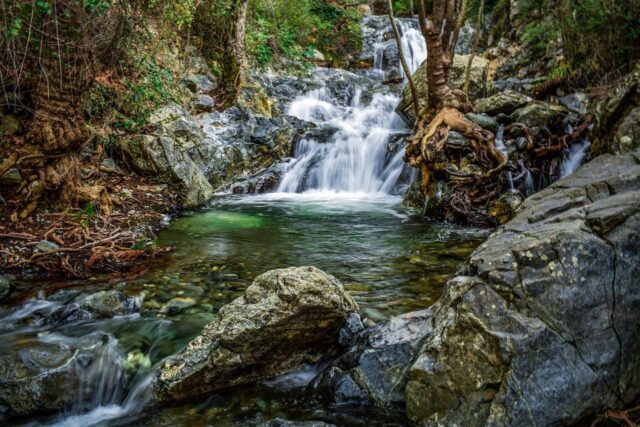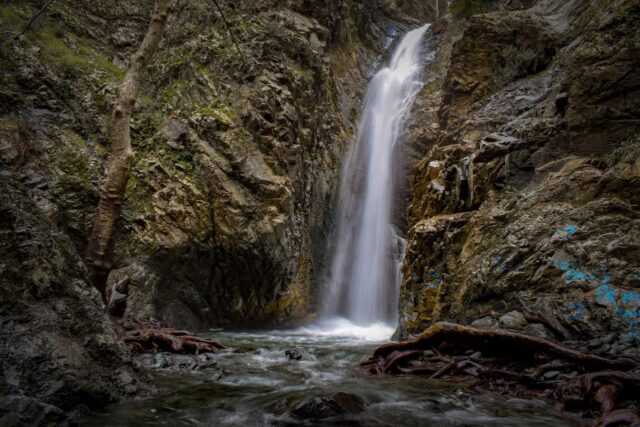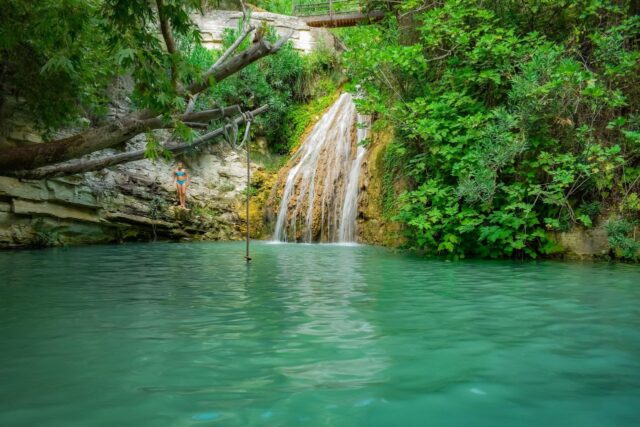Cyprus is known for its beaches and mild climate, but beyond the seascapes, the island also boasts stunning natural wonders hidden in the Troodos Mountains. Dozens of waterfalls—small and powerful, seasonal and permanent—tumble among pine forests, plane trees, and cliffs. They create a contrast to the sultry coastal regions and offer a glimpse of a different side of Cyprus—cool, green, and pristine.
Most of Cyprus’s waterfalls are concentrated in the Troodos mountain range, the island’s natural heart. Numerous rivers and streams, fed by snow and rain, originate here. In winter and spring, the waterfalls are particularly full-flowing, while in summer, many become thin threads flowing over the rocks.
The water in these streams is crystal clear as it passes through layers of limestone and basalt, becoming infused with minerals. The vegetation around the waterfalls is typical of the Cypriot mountains—plane trees, olive trees, junipers, hazels, wild violets, and lavender bushes. The air is cool and scented with pine needles, and the sound of the water creates an atmosphere of complete oneness with nature.

Contents
Caledonia Falls
The island’s most popular waterfall is Caledonia Waterfall, located near the village of Platres in central Troodos. It’s approximately 12 meters high, and its water cascades over basalt cliffs into a small mountain lake.
A roughly 3-kilometer-long trail leads to the waterfall, starting near the Psilo Dendro café. The path winds through a dense pine forest along the Krios Potamos River. The walk takes about an hour and is suitable even for families with children.
The name “Caledonia” comes from a Scottish officer in the British army who served in Cyprus in the 19th century. Enchanted by the place, he compared it to the natural beauty of his native Scotland, Caledonia. Today, it is one of the island’s most visited natural sites, especially in summer, when tourists seek refuge from the heat.
Millomery Falls
Millomeri Waterfall is located in the village of Platres, in the upper Troodos region. At approximately 15 meters high, it is the tallest natural waterfall in Cyprus.
The path to it starts from the village center and follows a marked trail among pine and juniper trees. The final section leads to a narrow gorge where a stream of water falls from a great height, creating a cloud of spray and a pleasant coolness.
Millomeri is especially impressive in spring, when meltwater from the mountain peaks intensifies the flow. This place is popular with photographers and trekkers, combining the beauty of the landscape with the accessibility of the route.

Mesa Potamos Waterfall
Mesa Potamos Situated between the villages of Saitas and Platres, it is considered one of the most picturesque and secluded waterfalls on the island. It is approximately 7 meters high, but its surroundings give it a special charm: rocks, mosses, and dense vegetation create the feeling of being in a tropical forest.
Near the waterfall is the Monastery of St. John Lampadista and a viewing platform with panoramic views of the valley. The area is ideal for picnics, relaxation, and meditation. The road here is partially unpaved, so it’s best to arrive by SUV.
Hantu Falls (Chantara)
Chantara Waterfall (Chantou) is located near the village of Fini, not far from Platres. It’s about 8 meters high, and its water falls into a small rock pool. Locals call it “Aphrodite’s Waterfall,” as legend has it that the goddess of love loved to bathe here with her nymphs.
According to another legend, Khantu got its name from the sound of falling water: “han-tara” translates from Turkish as “murmuring, singing water.” The path to the waterfall is short, about a kilometer, but the last few meters require caution due to the rocky trail.
This is one of the most atmospheric places in Troodos – the sound of water, dense vegetation and the absence of crowds create a feeling of solitude.

Cantares Waterfall
Eastern Cyprus is less known for its mountains, but it also has its share of waterfalls. One of them is Kantara Waterfall, located in the Ayia Napa area, near the castle of the same name. It’s not very tall, but surrounded by dense vegetation, creating a natural pond where you can cool off in the summer.
A narrow path through eucalyptus groves leads to it, and nearby are observation platforms overlooking the sea. It’s a great place for a short walk and a break away from the bustle of the beach.
Adonis Falls
Adonis Baths Waterfalls is one of the most unusual waterfalls in Cyprus, located near Paphos, near the village of Koili. Unlike the mountain streams of Troodos, this waterfall is man-made, but it is located in a picturesque natural setting, along the Morphon River.
Two tiers of waterfalls form here, each with a small emerald pool for swimming. According to myth, it was here that the goddess Aphrodite met Adonis, and this place was considered sacred for lovers.
The complex features statues of ancient Greek gods and bridges, and the water is said to have rejuvenating properties. Although there is an entrance fee, the site is popular with tourists and photographers.

Armeni Waterfall
Less well-known but no less beautiful, Arminou Waterfall is located near the village of Armeni, south of Troodos. It’s a seasonal waterfall, most spectacular in March and April. It’s about 10 meters high, and in spring, the water forms a cascade that cascades into a valley lined with orange trees.
The place is almost untouched by civilization and rarely visited by tourists, so Armeni remains one of the hidden gems of Cyprus.
Best time to visit
The peak activity of Cyprus’ waterfalls occurs between December and May, when the mountains receive sufficient rainfall. In spring, the water is clearest and fullest, and the air is filled with the scent of blooming grasses. In summer, many streams dry up, but cool spots remain worth visiting for the views and walks.
It is recommended to wear comfortable shoes, take water, and a camera—most of the routes run along natural trails, where it is easy to linger longer than planned.
Practical advice
- The best way to travel to the waterfalls is by car, combining visits to several places in one day.
- In Troodos, it’s important to take into account temperature fluctuations: in the mountains, it can be 10 degrees cooler than on the coast.
- There are picnic areas, but please take your trash with you—all waterfalls are protected areas.
- In spring, some trails may have wet ground, so it’s a good idea to wear shoes with good traction.
A visit to Cyprus’s waterfalls offers a chance to see a different side of the island: cool, vibrant, and green. These places offer a sense of solitude and tranquility, a contrast to the bustling resorts. The water, coolness, and silence create a natural harmony difficult to find elsewhere in the Mediterranean.
Here you can stroll through the forests, take rare photographs, breathe in the scent of pine trees, and feel that even under the Cypriot sun there are corners where eternal spring reigns.

















